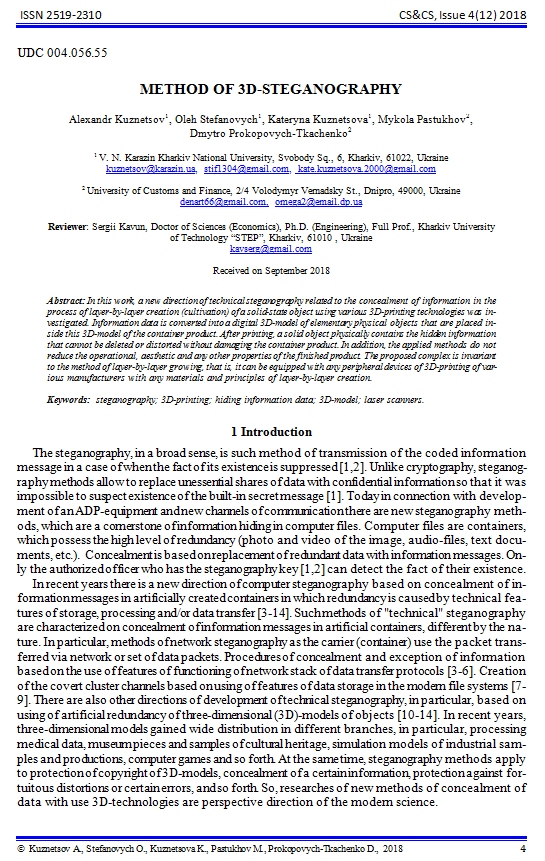Method of 3D-steganography
Abstract
In this work, a new direction of technical steganography related to the concealment of information in the process of layer-by-layer creation (cultivation) of a solid-state object using various 3D-printing technologies was investigated. Information data is converted into a digital 3D-model of elementary physical objects that are placed inside this 3D-model of the container product. After printing, a solid object physically contains the hidden information that cannot be deleted or distorted without damaging the container product. In addition, the applied methods do not reduce the operational, aesthetic and any other properties of the finished product. The proposed complex is invariant to the method of layer-by-layer growing, that is, it can be equipped with any peripheral devices of 3D-printing of various manufacturers with any materials and principles of layer-by-layer creation.
Downloads
References
Katzenbeisser S., Petitcolas F. A. Information Hiding Techniques for Steganography and Digital Watermarking. Norwood, MA, USA: Artech House, 2000. 220 p.
Petitcolas F. A. P., Anderson R. J., Kuhn M. G. Information hiding-a survey. Proceedings of the IEEE.1999. Vol. 87, №7. P. 1062–1078.
Mazurczyk W., Smolarczyk M., Szczypiorski K. Retransmission steganography and its detection. Soft Computing. 2011. Vol.15, №3. P. 505–515.
Length based network steganography using UDP protocol/ Nair A. S., Kumar A., Sur A., Nandi S. 2011 IEEE 3rd International Conference on Communication Software and Networks. Xi'an, 2011. P. 726–730.
Ahsan K., Kundur D. Practical data hiding in TCP/IP. ACM Workshop on Multimedia and Security, 2002. URL: https://www.gray-world.net/es/papers/acm02.pdf
TCP/IP Timing Channels: Theory to Implementation / Sellke S. H., Wang C., Bagchi S., Shroff N. B. 2009. P. 2204–2212.
Designing a cluster-based covert channel to evade disk investigation and forensics/ Khan H., Javed M., Khayam S.A., Mirza F. Computers & Security. 2011. Vol. 30, Issue 1. URL: https://www.sciencedirect.com/science/article/pii/ S016740481000088X
Evading Disk Investigation and Forensics using a Cluster-Based Covert Channel/ Khan H., Javed M., Khayam S.A., Mirza F. National University of Science & Technology (NUST), Islamabad 44000, Pakistan. URL: https://www.sigsac.org/ccs/CCS2009/ pd/abstract_17.pdf
Covert Channel for Cluster-based File Systems Using Multiple Cover Files / Morkevičius N., Petraitis G., A. Venčkauskas, J. Čeponis. Information Technology and Control. 2013. Vol. 42, №3. P. 32. URL:http://itc.ktu.lt/index.php/ITC/article/ view/3328
Rani R., Deep G. Digital 3D barcode image as a container for data hiding using steganography. 2017 4th International Conference on Signal Processing, Computing and Control (ISPCC). Solan, 2017. P. 325–330.
Sun Z., Lu Z. M., Li Z. Reversible Data Hiding for 3D Meshes in the PVQ-Compressed Domain. 2006 International Conference on Intelligent Information Hiding and Multimedia. Pasadena, CA, USA, 2006. P. 593–596.
A Benchmark for 3D Mesh Watermarking / Wang K., Lavoué G., Denis F., Baskurt A., He X. 2010 Shape Modeling International Conference. Aix-en-Provence, 2010. P. 231–235.
D Multimedia Protection Using Artificial Neural Network /Motwani M. C., Bryant B. D., Dascalu S. M. , Harris Jr. F. C. 2010 7th IEEE Consumer Communications and Networking Conference. Las Vegas, NV, 2010. P. 1–5.
Vasić B. Annotation of cultural heritage 3-D models by robust data embedding in the object mesh. 2014 22nd Telecommunications Forum Telfor (TELFOR). Belgrade, 2014. P. 842–849.
Kuznetsov A.A., Kovalenko O.Yu. Steganographic protection of information using 3D printing. Information Security of the State, Society and Personality: A Collection of Abstracts of the All-Ukrainian Scientific and Practical Conference, April 16, 2015. Kirovograd: KNTU, 2015.P. 91–92. (in Ukrainian)


